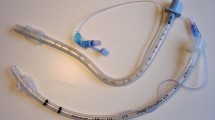Abstract
Despite improvements in tube design and materials, the longer survival rates of critically ill patients make laryngeal and tracheal lesions still common following prolonged translaryngeal intubation. The time of intubation is almost the only factor employed in deciding whether or not tracheotomy has to be performed. Some patients will not develop laryngeal lesions afer long intubation periods, whereas some already have clinical symptoms after short periods of time. If the conditions of the larynx and trachea could be assessed before irreversible complications take place, then timing of tracheotomy could be individualized to avoid laryngeal stenosis as well as unnecessary tracheostomies. We present the preliminary results of an endoscopic study of the early laryngeal changes that take place during translaryngeal intubation. The method of exploration is explained and tissue changes seen and their evolution after extubation are described, emphasizing those that could have a predictive value.
Similar content being viewed by others
References
Benjamin B (1993) Prolonged intubation injuries of the larynx: endoscopic diagnosis, classification, and treatment. Ann Otol Rhinol Laryngol 102 [Suppl 160]: 1–15
Contencin P, Fligny Y, François M, Bobin S, Manac'h Y, Narcy P (1989) Traitement chirurgical des stenoses laryngées severes de l'enfant. Ann Otolaryngol Chir Cervicofac 106: 255–257
Cotton RT, Zalzal GH (1993) Glottic and subglottic stenosis. In: Cummings C (ed) Otolaryngology-head and neck surgery, 2nd edn, vol 3. Mosby, St. Louis, pp 1981–2000
Donnelly WH (1969) Histopathology of endotracheal intubation. An autopsy study of 99 cases. Arch Pathol 88: 511–520
Gaynor EB, Greenberg SB (1985) Ontoward sequelae of prolonged intubation. Laryngoscope 95: 1461–1467
Heffner JE (1989) Medical indications for tracheostomy. Chest 96: 186–190
Rodríguez JL, Steinberg SM, Luchetti FA, Gibbons KJ, Taheri PA, Flint LM (1990) Early tracheostomy for primary airway management in the surgical critical care setting. Surgery 108: 655–659
Rügheimer E (1990) Langzeitintubation and Tracheotomie. Langenbecks Arch Chir [Suppl II]: 1093–1099
Santos PM, Afrassiabi A, Weimuller EA (1994) Risk factors associated with prolonged intubation and laryngeal injury. Otolaryngol Head Neck Surg 111: 453–459
Stauffer JL, Olson DE, Petty TP (1981) Complications and consequences of endotracheal intubation and tracheotomy. A prospective study of 150 critically ill patients. Am J Med 70: 65–76
Verhulst J, Adjoua RP, Urtazun H (1992) Les complications laryngées et trachéales de l'intubation prolongée. Rev Laryngol 113:289–294
Weymuller EA (1988) Laryngeal injury from prolonged endotracheal intubation. Ann Otol Rhinol Laryngol 98 [Suppl 45]: 1–15
Withed RE (1984) A prospective study of laryngotacheal sequelae in long-term intubation. Laryngoscope 94: 367–377
Author information
Authors and Affiliations
Rights and permissions
About this article
Cite this article
Vila, J., Bosque, M.D., García, M. et al. Endoscopic evolution of laryngeal injuries caused by translaryngeal intubation. Eur Arch Otorhinolaryngol 254 (Suppl 1), S97–S100 (1997). https://doi.org/10.1007/BF02439735
Issue Date:
DOI: https://doi.org/10.1007/BF02439735




